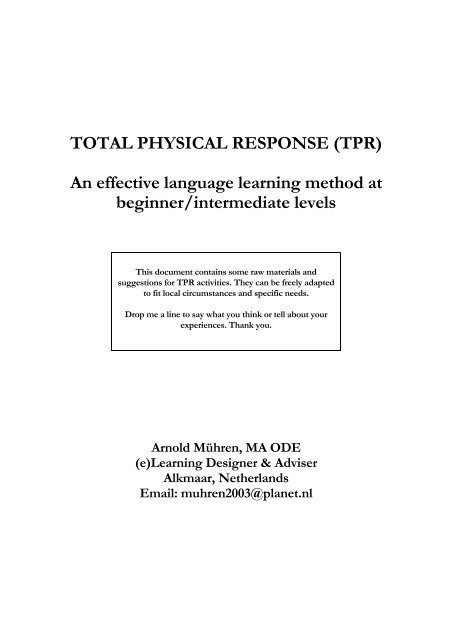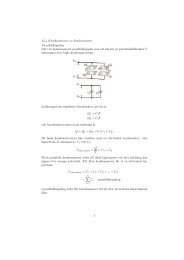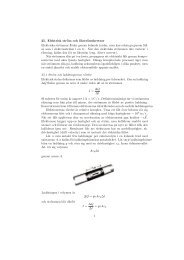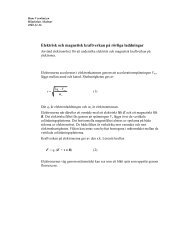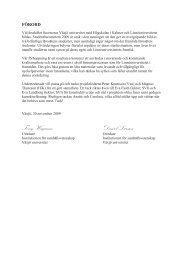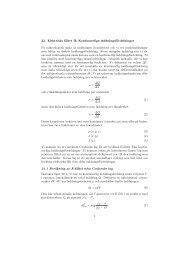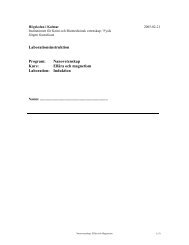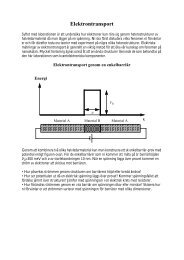Create successful ePaper yourself
Turn your PDF publications into a flip-book with our unique Google optimized e-Paper software.
<strong>TOTAL</strong> <strong>PHYSICAL</strong> <strong>RESPONSE</strong> (<strong>TPR</strong>)<br />
An effective language learning method at<br />
beginner/intermediate levels<br />
This document contains some raw materials and<br />
suggestions for <strong>TPR</strong> activities. They can be freely adapted<br />
to fit local circumstances and specific needs.<br />
Drop me a line to say what you think or tell about your<br />
experiences. Thank you.<br />
Arnold Mühren, MA ODE<br />
(e)Learning Designer & Adviser<br />
Alkmaar, Netherlands<br />
Email: muhren2003@planet.nl
INTRODUCTION<br />
Total Physical Response (<strong>TPR</strong>) is the name given to a learning strategy which has been developed<br />
and promoted by Professor James Asher of San José State University in California. It is now being<br />
practised successfully by many teachers all over the world. Its scope, however, seems limited: it is not<br />
known to be used beyond beginner level.<br />
The basic technique of <strong>TPR</strong> is simple. Learners act out commands given by the teacher or their<br />
fellow pupils (at a later stage). These commands, or series of commands, are simple at the beginning<br />
(stand up, sit down) but after some time they may become more complex (I want the boys to stand in a circle<br />
please). A <strong>TPR</strong> sequence can be a chain of actions relating to a compound task (take pen and paper, sit<br />
down, begin at the top of your paper, write down: Dear ...) or even contain a story-line.<br />
Learning to understand and respond to language physically is something all - normally gifted -<br />
learners can do well. As a result they feel successful as a student and they experience the enjoyment<br />
of easy learning (in the first year or so). They are usually surprised about the speed with which they<br />
learn to understand English.<br />
Learners are totally involved in <strong>TPR</strong> activities because they are allowed to concentrate on one thing<br />
only: they act out what they've heard. There is no pressure on them to speak the foreign language<br />
yet. This is with good reason. Before any learner can start to speak a foreign language spontaneously<br />
and creatively he or she must feel the inner readiness to do so. When learners are ready they feel that<br />
the words of the language - sound and meaning integrated and combined into larger utterances -<br />
spring from within themselves. This inner readiness will develop gradually but inevitably with prolonged<br />
exposure to the sound of understood language and an active involvement in its meaning. <strong>TPR</strong><br />
has proved to be an effective learning strategy in this respect.<br />
Total Physical Response can be an integral part of any English lesson, especially at beginner level.<br />
During the first few weeks of an English starter course at school <strong>TPR</strong> may even be the main activity<br />
that the learners are involved in. A 'bookless' period impresses upon the learners the notion that<br />
language is basically meaningful sound (rather than words on paper).<br />
In this booklet you will find examples of basic procedures and some <strong>TPR</strong> sequences of various<br />
kinds. After reading this document you may want to create some materials yourself.<br />
Good luck.<br />
1
STARTING WITH <strong>TOTAL</strong> <strong>PHYSICAL</strong> <strong>RESPONSE</strong><br />
In the following units pupils learn language which is relating to people and things nearest to them<br />
when they are at school: the classroom and the objects in it, numbers and colours, themselves and<br />
their fellow pupils (their body parts, their clothes).<br />
UNIT A<br />
Preparation<br />
Write the words of the sets below on little cards for easy handling and varying the order of the<br />
commands.<br />
Basic procedure<br />
1 Sit in front of the classroom. Place two chairs on either side of.<br />
2 Ask four pupils to come up to the front of the class and have them sit on either side of you,<br />
facing the group.<br />
Say 'stand' and immediately stand up as you motion the pupils on your sides to do the same.<br />
Then say 'sit' and sit down and motion the pupils to do the same. Repeat this a couple of<br />
times.<br />
Then say 'stand' to the whole group and motion them to stand; then say 'sit' and modelling<br />
the action have the group do the same. Repeat this a couple of times.<br />
Switch to your group of four and repaet the procedure without modelling the action<br />
yourself.<br />
Then repeat this procedure with the whole group. Say 'very good, children, you can<br />
understand English now.'<br />
Do set A1 in the same manner, varying and repeating the commands and switching from<br />
the group of four to the whole group.<br />
A1 Words head, back, face, chest<br />
to sit, to stand, to touch<br />
Touch your head.<br />
Sit.<br />
Touch your back.<br />
Stand.<br />
Touch your chest.<br />
Sit.<br />
Touch your head.<br />
Touch your back.<br />
2
Stand.<br />
Touch your face.<br />
Touch your face.<br />
...<br />
Note. The teacher goes on as long as it takes to get quick and unhesitating responses from the pupils<br />
with all items. The action must be lively.<br />
A2 New words arm, leg, elbow, knee, foot, toe, shoulder<br />
left, right<br />
Touch your chest.<br />
Touch your left arm.<br />
Touch your left hand.<br />
Touch your right elbow.<br />
Touch your right foot.<br />
Touch your left shoulder.<br />
Touch your back.<br />
Touch your right leg.<br />
Touch your left knee.<br />
Touch your right shoulder.<br />
Touch your chest.<br />
Touch your right arm.<br />
Touch your left elbow.<br />
Touch your ...<br />
UNIT B<br />
B1 Revision of the words in unit A<br />
Touch your head.<br />
Touch your right leg.<br />
Touch your chest.<br />
Touch your left elbow.<br />
Touch your right shoulder.<br />
Touch your left foot.<br />
Touch your right knee.<br />
Touch your back.<br />
Touch your ..<br />
B2 New words finger, thumb, nose, hair, chin, mouth, ear, eye<br />
put, open, close<br />
Open your mouth.<br />
Close your mouth.<br />
3
Put a finger on your mouth.<br />
Put a finger on your nose.<br />
Put your hand on your hair.<br />
Put your left thumb on your chin.<br />
Close your left eye.<br />
Open your left eye.<br />
Close your right eye.<br />
Open your right eye.<br />
Put a thumb on your left ear.<br />
Put a thumb on your right ear.<br />
Put your hands on your face.<br />
Put your hands on your head.<br />
Put two fingers on your chin.<br />
Close your eyes.<br />
Open your eyes.<br />
...<br />
B3 New words neck, cheek, lip, tongue, tooth/teeth, eyebrow, forehead<br />
to show<br />
Show me your teeth.<br />
Show me your tongue.<br />
Put a finger on your tongue.<br />
Put a finger on one tooth.<br />
Put your hands on your cheeks.<br />
Touch your forehead.<br />
Touch your left eyebrow.<br />
Touch your right eyebrow.<br />
Put a finger on your lips.<br />
Show me your teeth.<br />
Touch your left eyebrow.<br />
Put a hand on your neck.<br />
Put a finger on your right cheek.<br />
Touch your tongue.<br />
Put your right hand on your forehead.<br />
...<br />
UNIT C<br />
C1 Revision of the words from units A and B<br />
Do it! - A game<br />
The teacher gives commands without modelling the action himself/herself. The pupils respond to<br />
the commands. Anyone making a misatake is 'out'. The teacher starts with simple commands, but<br />
these will get more complicated as the game continues.<br />
4
Touch your nose.<br />
Touch your right ear.<br />
Touch your chest.<br />
Touch your left eyebrow.<br />
Put a finger on your lips.<br />
Touch your right ear.<br />
Put your right hand on your forehead.<br />
...<br />
C2 New words blue, yellow, green, orange, brown, grey, purple, black, white<br />
card<br />
to pick up<br />
Preparation<br />
A number of small coloured cards, one of more cards on every pupil's desk, a set of cards on a<br />
central desk.<br />
Procedure<br />
1 The teacher picks up cards one by one and says what colour they are.<br />
A blue card.<br />
An orange card.<br />
A yellow card.<br />
A red card.<br />
A brown card.<br />
A grey card.<br />
A purple card.<br />
A black card.<br />
A white card.<br />
A green card<br />
Red.<br />
Blue.<br />
Purple.<br />
...<br />
2 The teacher gives commands to the class.<br />
Who's got a red card? Show it to me.<br />
Who's got a blue card? Show it to me.<br />
Who's got a yellow card? Show it to me.<br />
...<br />
3 The teacher invites individual pupils to come out to the central desk.<br />
Devi, pick up a purple card and show it to the class.<br />
Show the class a black card.<br />
Show the class a green card.<br />
5
Show the class a grey card.<br />
Ridwan, ...<br />
C3 New words jump, run, hop, stop<br />
on the spot<br />
Preparation<br />
Every pupil holds a coloured card, there are five of six different colours.<br />
Procedure<br />
1 The pupils stand in a circle.<br />
2 The teacher gives commands and models the action. After a while he/she stops modelling.<br />
Pupils with blue cards, jump up and down. ... Stop.<br />
Pupils with red cards, run on the spot. ... Stop.<br />
Pupils with yellow cards, hop one one leg. ... Stop.<br />
Pupils with brown cards, walk on the spot. ... Stop.<br />
Pupils with orange cards, hop on your left foot. ... Stop.<br />
Blue cards, run on the spot. ... Don't stop.<br />
White cards, jump up and dopwn. ... Don't stop.<br />
Brown cards, walk on the spot. ... Don't stop.<br />
Blue cards, stop running on the spot.<br />
Orange cards, hop on right leg. ... Don't stop.<br />
Brown cards, stop walking on the spot.<br />
UNIT D<br />
D1 Revision of the words from units A, B and C<br />
D2 New words window, door, wall, ceiling, floor, chair, desk/table, blackboard, bookcase<br />
to walk<br />
Point to the blackboard.<br />
Walk to the door.<br />
Point to the window.<br />
Walk back to your chair.<br />
Touch your desk.<br />
Point to a wall.<br />
Point to the ceiling.<br />
Point to the bookcase.<br />
Touch the floor.<br />
Walk to the window.<br />
Open the window.<br />
Close the window.<br />
Walk to the door.<br />
Point to the ceiling.<br />
6
Touch your chair.<br />
Touch your desk.<br />
Touch a wall.<br />
Touch the blackboard.<br />
Touch the floor.<br />
...<br />
NOTE. Some commands had better be carried by just one pupil. Phrases to select a pupil:<br />
Just you, Peter. Open the window.<br />
You on your won, Bill. Point to a wall.<br />
D3 New words chalk, coloured chalk, eraser, paper, pen, pencil, book, exercise book<br />
to take, to come, to sit, to hold up<br />
Preparation<br />
The above items are on a central desk or table and (a number of them) on the pupils' desks (i.e. the<br />
items normally present there).<br />
Procedure<br />
1 The teacher identifies the objects by simply picking them up from the desk and saying their names.<br />
A piece of chalk. White chalk.<br />
Coloured chalks.<br />
An eraser.<br />
A sheet of paper.<br />
A pen.<br />
A pencil.<br />
A book.<br />
An exercise book<br />
Again. A piece of chalk.<br />
Coloured chalk.<br />
...<br />
2 The teacher gives the class commands relating to the items on the pupils's desks.<br />
Hold up your pens.<br />
Put down your pens.<br />
Hold up your pencils.<br />
Put them down.<br />
Hold up your books.<br />
Put them down.<br />
Show me your erasers.<br />
Show me your exercise books.<br />
Show me your books.<br />
...<br />
7
INTEGRATING <strong>TPR</strong> IN THE ENGLISH COURSE<br />
<strong>TPR</strong> can be integrated in the English course in use at school by selecting vocabulary from the<br />
textbook that can be acted out and arranging these words and structures in <strong>TPR</strong> sets. These sets can<br />
be used in the presentation stage of each lesson or lesson activity.<br />
Even the cover of a student's book might be used to do a <strong>TPR</strong> activity with the pupils sitting<br />
comfortably at their desks:<br />
Point to the television set.<br />
Point to the ice creams.<br />
Where is the information desk?<br />
Count all the people in the page. How many are there?<br />
Show me the monkey.<br />
Give your neighbour an injection in the left arm.<br />
Shake hands with your neighbour.<br />
Count all the animals on the page. How many are there?<br />
Show me how you eat a sandwich.<br />
Shout: 'Goal!'<br />
Blow air from your lungs.<br />
Revision of vocabulary is essential. It wil take only five to ten minutes per lesson period to do so.<br />
<strong>TPR</strong> revision sets may look like the following two which are sets of randomly arranged actions.<br />
1<br />
Put one hand on your arm.<br />
Put your hand on the back of your chair.<br />
Put your hand on your back.<br />
Touch one ear.<br />
Give that pencil (or book) to me.<br />
Look happy.<br />
Put one hand on your leg.<br />
Take a match out of a box of matches.<br />
Ask a question.<br />
Read a book.<br />
Look sad.<br />
Do you sit at desk or a table.<br />
2<br />
Blow air from your lungs.<br />
Show me one hand. And the other.<br />
What day is today?<br />
Go to the door.<br />
Carry a heavy bag. And a light one.<br />
8
Say: 'How are you today?'<br />
Take your book and open it.<br />
Walk to the door.<br />
9
<strong>TPR</strong> SEQUENCES AT POST-BEGINNER LEVEL<br />
The following <strong>TPR</strong> sequences can be acted out but there are more ways to use them. Take the first<br />
sequence: Going out for a walk. Writing is one of things you can do: I stood up from my chair and<br />
turned off the radio because I wanted to go out for a walk (and so on). Pupils may find it interesting<br />
to write and act out a dialogue between a policeman and somebody who must account for his<br />
actions on a certain night. The detailed actions in the sequence may be used freely and details can<br />
easily be added by the 'suspect'. Sequences like these can be used in many different communicative<br />
ways - it is a matter of creativity.<br />
Going out for a walk<br />
(You are listening to the radio.)<br />
Stand up from your chair.<br />
Go to the radio.<br />
Turn it off.<br />
Go to the window.<br />
Look outside.<br />
Sit down again.<br />
Pick up your shoes.<br />
Put them in front of you.<br />
Pull up your socks.<br />
Put your shoes on.<br />
Stand up.<br />
Walk to the door.<br />
Open it.<br />
Go outside.<br />
Close the door behind you.<br />
Take out your key.<br />
Put it in the keyhole.<br />
Lock the door.<br />
Look up at the sky.<br />
Walk away.<br />
Writing a letter<br />
Pick up your pen.<br />
Begin at the top of the paper: Dear...<br />
Write your letter.<br />
Look up from your paper.<br />
Look sad.<br />
Put down your pen.<br />
Rub your eyes.<br />
Pick up your pen.<br />
Go on writing.<br />
Stop writing.<br />
Put down your pen.<br />
Put one hand under your chin.<br />
Think.<br />
Look happy.<br />
Go on writing.<br />
Look up at the clock behind you.<br />
Finish your letter.<br />
Fold the letter.<br />
Take an envelope.<br />
Put the letter inside.<br />
Lick the flap, stick it down.<br />
Write the address on the envelope.<br />
Pick up a stamp, lick it, stick it on.<br />
Stand up.<br />
Run to the letterbox outside.<br />
Hurry up! Hurry up!<br />
10
A <strong>TPR</strong> SONG<br />
Children enjoy singing. There are lots of action songs. The pupils sing and act out the words of the<br />
song. 'This is the way ...' is an example of an action song.<br />
This is the way you wash your face<br />
wash your face, wash your face.<br />
This is the way you wash your face<br />
All on a Saturday morning.<br />
This is the way you wash your hands<br />
wash your hands, wash your hands<br />
This is the way you wash your hands<br />
All on a Sunday morning.<br />
This is the way you brush your teeth (...)<br />
All on a Monday morning<br />
This is the way you brush your hair (...)<br />
All on a Tuesday morning.<br />
This is the way you clean your shoes (...)<br />
All on a Wednesday morning.<br />
This is the way you eat your food<br />
All on a Thursday morning.<br />
This is the way you drink your tea (...)<br />
All on a Friday morning.<br />
You may know other songs which are full of actions and can be used in the same way.<br />
11
ACKNOWLEDGEMENTS<br />
Mooijman, J.P. & A.H. van den Bos. I spy. In search of meaning, NIB Zeist, Netherlands.<br />
Mooijman, J.P. & A.H. van den Bos. 'Total Physical Response' in Practical Teaching, MPG London.<br />
Mühren, A. Into English, Thieme Zutphen, Netherlands.<br />
Segal, Bertha. Teaching English Through Actions. Bertha Segal, Inc., Brea, California.<br />
Silvers, Stephen Mark. The Command Book, Sky Oaks Productions, Inc., P.O.Box 1102, Los Gatos,<br />
California 95031.<br />
Tomscha, T. 'Using Total Physical Response communicatively' in Practical English Teaching, MPG<br />
London.<br />
12


